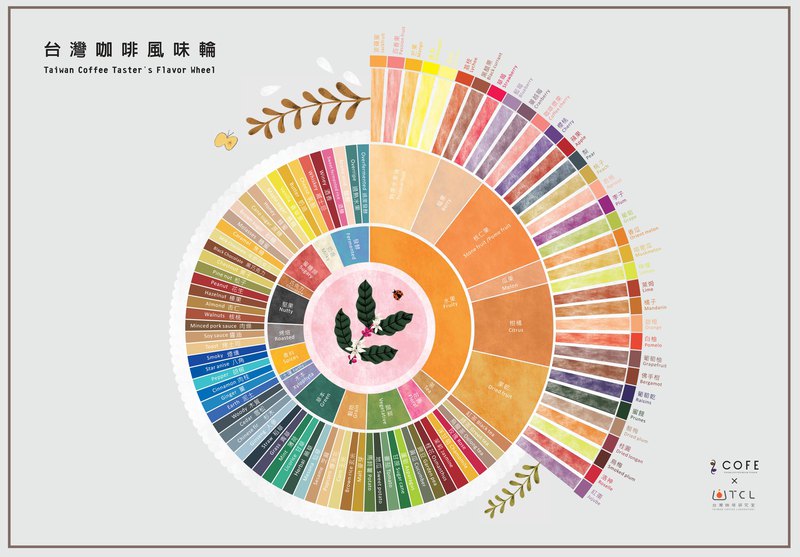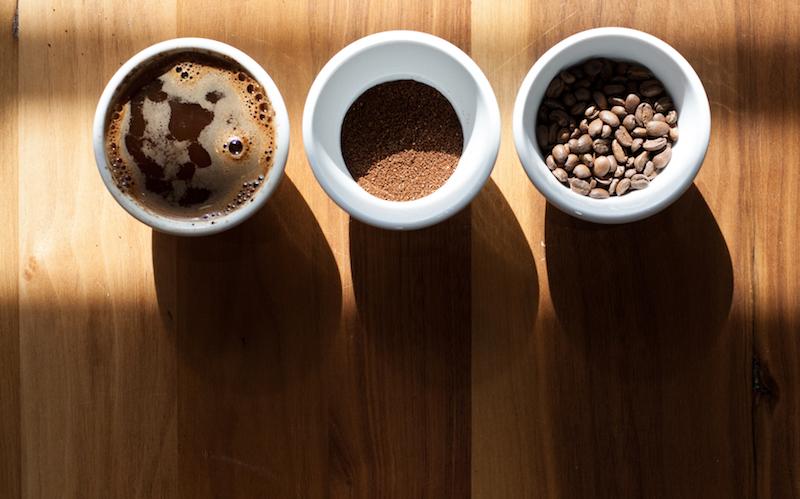There is a secret to getting started quickly! Beginners learn to disassemble first!
Professional coffee knowledge exchange more coffee bean information please follow the coffee workshop (Wechat official account cafe_style)
The taste of coffee belongs to a compound feeling, which can be divided into three stages when learning to taste: first, you should understand the factors that make up the taste, and then you can disassemble and analyze the factors during the taste. and then be able to detect more delicate taste and meticulous changes.

The taste of coffee can be subdivided into three categories: smell (aroma), taste and taste. In the mouth, coffee can be roughly divided into upper smell (aroma), middle taste and lower taste. Because the aroma factors of coffee are very complex, and everyone has different feelings about various smells, even if it is not easy for everyone to get the same answer in the same cup of coffee. Therefore, the aroma part simply takes the common and obvious aroma of coffee as an example:
Bouquet: floral, fruity (citrus, berry), drupe (peanut, hazelnut). Wait.
Taste: stickiness, smoothness, astringency, powder, silk. Wait.
Taste: sweet, sour, salty, bitter, sweet.
Learning to taste is to first be familiar with all kinds of taste, most people in the diet, will focus on the taste, at the same time, the taste is also easier to distinguish, so you have to remember to distinguish all kinds of taste.
Then there is the analysis of the taste change. The taste in the coffee is limited, but the taste intensity is changeable, so when learning to taste, we should try to disassemble and arrange the taste of the coffee and position it as much as possible to see whether the taste change is going up or going up at the same time. Wait.
To analyze the change of taste, it is best to use someone who knows how to taste to drink the same cup of coffee with you, explain the order of taste change and guide it timely, taste it carefully and find out the change, and wait until you can drink a certain degree of fineness. Relative to the changes of aroma will also have further understanding and understanding, coupled with the usual attention and memory of various aromas In this way, you can quickly know how to taste!
The feeling of smell is directly related to personal memory, the same smell, because everyone has different memories of the taste, not always have the same name for a single aroma, so it is necessary to communicate with each other in order to agree on the types of aroma.
Beginners do not have to struggle: the discrimination of learning taste takes precedence over the identification of aroma!
Coffee contains a wide range of aroma components, and even some can be analyzed by machines, but not everyone can tell. For example, from the beginning of aroma learning, it is necessary to accumulate the memory of various aromas at the beginning, then identify them in the coffee, and further identify the compound aroma, and there are other factors in the process that affect the judgment (changes in taste and taste), so it is more complex and difficult to learn.
The taste of coffee is sweet, sour, salty, bitter and sweet, and these five tastes are familiar to people, and they are less difficult to distinguish than aroma, so it is easier to learn from the beginning of taste. Interestingly, the instrument can only help to judge the strength of the taste, but can not show the changes between them. The coffee liquid begins to slide across the whole tongue from the tip of the tongue to be swallowed, such as sour → sweet → bitter → sweet layer, coffee can also make people feel more wonderful through these changes, simple sweetness and slightly sour or slightly salty sweetness will make people feel more sweet Like a watermelon with a little salt, it can make people feel sweeter, so learn to savor the changes in taste and appreciate the delicate side of coffee. In addition, while recognizing the changes in taste, we can also further detect the changes in aroma changes, what aromas are there when sour aromas appear, what aromas are there when sweet flavors appear, and when the same aroma is matched with different flavors, will it still give people the same feeling?
Tasting is to try to feel the delicate changes in the taste and aroma of disassembly, which can be roughly divided into several stages based on personal learning experience:
The first stage: can accept the taste of coffee, can roughly tell the difference in taste, can not be specifically described.
The second stage: have a certain understanding of coffee and "guess" the taste of coffee according to its cognition; for example, when drinking Kenya, you will guess that there is a berry flavor, but the Kenyan bean is not necessarily the trend of berry flavor.
The third stage: have the ability to disassemble and subdivide the taste of the entrance, and have a stable understanding of the defective flavor.
The fourth stage: the taste can be disassembled and subdivided and combined with its own extraction experience, it can distinguish the impact of extraction methods on the taste, and propose a way to correct the negative factors. According to different appliances, it can be divided into three types: hand-impact type, siphon type and Italian type concentration.
The fifth stage: the taste can be disassembled and subdivided, combined with baking experience, can dialyze the impact of baking on the taste, and propose a way to correct the negative factors.
How to learn more about the taste and aroma of coffee?
After the entrance of the coffee liquid, from the tip of the tongue, let the coffee liquid slide through the tongue and swallow it. Through the order of contact between the coffee liquid and the tongue, the taste and aroma are arranged in order, and can also be located on the tongue in this order. it can be roughly divided in front (tip of tongue), middle (belly of tongue) and back (root of tongue) to describe the position of taste and aroma. In this way, when discussing the taste of the same cup of coffee, it may be:
Do you feel sweet before you feel sour in the front of your tongue?
After the bitter taste disappears, it will turn sweet!
There is citrus fragrance when acid appears!
There are obvious sweetness and drupe aromas in the middle!
What is the smell sandwiched between sour and sweet in the first paragraph?
……
The taste of the same cup of coffee can be defined in this way, the difference lies in the degree of delicacy that each person feels and the memory of the aroma, which affects the feeling, but the sensibility of tasting can be trained.
Why should you have the ability to disassemble and subdivide the taste?
In terms of different extraction methods and techniques, the most direct impact is the change in taste and taste, so it is necessary to be familiar with the various changes of the two. The aroma part can be parallel, but it is not the focus of learning at the initial stage, for example:
Citrus aroma and sour taste will be orange at the same time!
Will the citrus aroma and sweetness be orange at the same time? Sweet orange?
The taste of citrus aroma and bitterness will be orange peel. (it's a little scary, I can't imagine)
Therefore, the purpose of cultivating the ability to disassemble subdivided flavors (such as orange flavor = citrus + sour taste) is to establish the identification of aroma without being affected by changes in taste and avoid misjudgment of taste.
Finally, have a cup of coffee! Try to discuss and communicate in this way!
END
Important Notice :
前街咖啡 FrontStreet Coffee has moved to new addredd:
FrontStreet Coffee Address: 315,Donghua East Road,GuangZhou
Tel:020 38364473
- Prev

What is the tasting period of coffee beans? What is the period of coffee and beans? How should coffee wake up and raise beans?
Professional coffee knowledge exchange more coffee bean information please follow the coffee workshop (Wechat official account cafe_style) "baking date" coffee beans roast date represents the freshness, usually 2-3 days roasted beans can be called fresh coffee beans. However, baking and buying is actually not the taste of beans.
- Next

Is it true that coffee is not bitter and drinks "sweet"? Coffee and strawberry and pineapple?
Professional coffee knowledge exchange More coffee bean information Please pay attention to coffee workshop (Weixin Official Accounts cafe_style)"coffee = bitter" This concept has been deeply rooted in most people's impression, but in fact coffee is indeed natural sweet, in the cup tester's evaluation table,"sweetness" is one of the evaluation measures, let's talk about the natural sweet coffee bar! that
Related
- How did the Salvadoran coffee industry develop in Central America?
- What exactly does the golden cup extraction of coffee mean?
- The Origin of Coffee flower
- [2023 Starbucks World Earth Day] there are more meaningful things besides free Starbucks coffee!
- What kind of coffee is there in Spain? 9 Flavors of Spanish Coffee
- Aromatic African coffee| Kenya's coffee culture and historical production area
- Liberica Coffee Bean knowledge: the characteristics of Liberian Coffee beans of the three original species of Coffee beans
- The origin and formula of Spanish latte introduces the taste characteristics of Bombon coffee in Valencia, Spain.
- How to adjust the solution of over-extracted coffee
- What is the tasting period of coffee beans? What is the period of coffee and beans? How should coffee wake up and raise beans?

